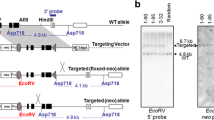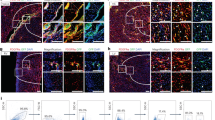Abstract
Basigin is a well-known extracellular stimulator of fibroblasts and may confer resistance to apoptosis of fibroblasts in vitro under some pathological status, but its exact function in fibroblasts and the underlying mechanism remain poorly understood. The systematic Basigin gene knockout leads to the perinatal lethality of mice, which limits the delineation of its function in vivo. In this study, we generated a fibroblast-specific Basigin knock-out mouse model and demonstrated the successful deletion of Basigin in fibroblasts. The fibroblast-specific deletion of Basigin did not influence the growth, fertility and the general condition of the mice. No obvious differences were found in the size, morphology, and histological structure of the major organs, including heart, liver, spleen, lung and kidney, between the knockout mice and the control mice. The deletion of Basigin in fibroblasts did not induce apoptosis in the tissues of the major organs. These results provide the first evidence that the fibroblast-specific Basigin knock-out mice could be a useful tool for exploring the function of Basigin in fibroblasts in vivo.





Similar content being viewed by others
References
Iacono, K. T., Brown, A. L., Greene, M. I., & Saouaf, S. J. (2007). CD147 immunoglobulin superfamily receptor function and role in pathology. Experimental and Molecular Pathology, 83, 283–295.
Crosnier, C., Bustamante, L. Y., Bartholdson, S. J., Bei, A. K., Theron, M., Uchikawa, M., Mboup, S., Ndir, O., Kwiatkowski, D. P., Duraisingh, M. T., Rayner, J. C., & Wright, G. J. (2011). Basigin is a receptor essential for erythrocyte invasion by Plasmodium falciparum. Nature, 480, 534–537.
Li, M., Zhai, Q., Bharadwaj, U., Wang, H., Li, F., Fisher, W. E., Chen, C., & Yao, Q. (2006). Cyclophilin A is overexpressed in human pancreatic cancer cells and stimulates cell proliferation through CD147. Cancer, 106, 2284–2294.
Belton, R. J. Jr., Chen, L., Mesquita, F. S., & Nowak, R. A. (2008). Basigin-2 is a cell surface receptor for soluble basigin ligand. Journal of Biological Chemistry, 283, 17805–17814.
Peng, F., Li, H., Ning, Z., Yang, Z., Li, H., Wang, Y., Chen, F., & Wu, Y. (2016). CD147 and prostate cancer: A systematic review and meta-analysis. PLoS ONE, 11, e0163678.
Xin, X., Zeng, X., Gu, H., Li, M., Tan, H., Jin, Z., Hua, T., Shi, R., & Wang, H. (2016). CD147/EMMPRIN overexpression and prognosis in cancer: A systematic review and meta-analysis. Scientific Reports, 6, 32804.
Miyauchi, T., Masuzawa, Y., & Muramatsu, T. (1991). The basigin group of the immunoglobulin superfamily: Complete conservation of a segment in and around transmembrane domains of human and mouse basigin and chicken HT7 antigen. The Journal of Biochemistry, 110, 770–774.
Grass, G. D., & Toole, B. P. (2015) How, with whom and when: An overview of CD147-mediated regulatory networks influencing matrix metalloproteinase activity, Bioscience Reports 36, e00283.
Hasaneen, N. A., Cao, J., Pulkoski-Gross, A., Zucker, S., & Foda, H. D. (2016). Extracellular matrix metalloproteinase inducer (EMMPRIN) promotes lung fibroblast proliferation, survival and differentiation to myofibroblasts. Respiratory Research, 17, 17.
Xu, J., Lu, Y., Qiu, S., Chen, Z. N., & Fan, Z. (2013). A novel role of EMMPRIN/CD147 in transformation of quiescent fibroblasts to cancer-associated fibroblasts by breast cancer cells. Cancer Letters, 335, 380–386.
Cirri, P., & Chiarugi, P. (2011). Cancer associated fibroblasts: The dark side of the coin. American Journal of Cancer Research, 1, 482–497.
Wang, J., Min, A., Gao, S., & Tang, Z. (2014). Genetic regulation and potentially therapeutic application of cancer-associated fibroblasts in oral cancer. Journal of Oral Pathology & Medicine, 43, 323–334.
Kim, Y. H., Jung, J. C., Jung, S. Y., Kim, Y. I., Lee, K. W., & Park, Y. J. (2015). Cyclosporine a downregulates MMP-3 and MMP-13 expression in cultured pterygium fibroblasts. Cornea, 34, 1137–1143.
Kuwata, H., Yuzurihara, C., Kinoshita, N., Taki, Y., Ikegami, Y., Washio, S., Hirakawa, Y., Yoda, E., Aiuchi, T., Itabe, H., Nakatani, Y., & Hara, S. (2018). The group VIA calcium-independent phospholipase A2 and NFATc4 pathway mediates IL-1beta-induced expression of chemokines CCL2 and CXCL10 in rat fibroblasts. The FEBS Journal, 285, 2056–2070.
Weber, C. E., & Kuo, P. C. (2012). The tumor microenvironment. Surgical Oncology, 21, 172–177.
Du, W., Du, W., & Yu, H. (2018) The role of fibroblast growth factors in tooth development and incisor renewal, Stem Cells International 2018, 7549160.
LeBleu, V. S., & Kalluri, R. (2018) A peek into cancer-associated fibroblasts: Origins, functions and translational impact, Disease Models & Mechanisms. https://doi.org/10.1242/dmm.029447.
Alguacil-Nunez, C., Ferrer-Ortiz, I., Garcia-Verdu, E., Lopez-Pirez, P., Llorente-Cortijo, I. M., & Sainz, B. Jr. (2018). Current perspectives on the crosstalk between lung cancer stem cells and cancer-associated fibroblasts. Critical Reviews in Oncology/Hematology, 125, 102–110.
Suzuki, K., Satoh, K., Ikeda, S., Sunamura, S., Otsuki, T., Satoh, T., Kikuchi, N., Omura, J., Kurosawa, R., Nogi, M., Numano, K., Sugimura, K., Aoki, T., Tatebe, S., Miyata, S., Mukherjee, R., Spinale, F. G., Kadomatsu, K., & Shimokawa, H. (2016). Basigin promotes cardiac fibrosis and failure in response to chronic pressure overload in mice. Arteriosclerosis Thrombosis and Vascular Biology, 36, 636–646.
Tang, Y., Kesavan, P., Nakada, M. T., & Yan, L. (2004). Tumor–stroma interaction: Positive feedback regulation of extracellular matrix metalloproteinase inducer (EMMPRIN) expression and matrix metalloproteinase-dependent generation of soluble EMMPRIN. Molecular Cancer Research, 2, 73–80.
Kanekura, T., Chen, X., & Kanzaki, T. (2002). Basigin (CD147) is expressed on melanoma cells and induces tumor cell invasion by stimulating production of matrix metalloproteinases by fibroblasts. International Journal of Cancer, 99, 520–528.
Zhai, Y., Wu, B., Li, J., Yao, X. Y., Zhu, P., & Chen, Z. N. (2016). CD147 promotes IKK/IkappaB/NF-kappaB pathway to resist TNF-induced apoptosis in rheumatoid arthritis synovial fibroblasts. Journal of Molecular Medicine, 94, 71–82.
Igakura, T., Kadomatsu, K., Taguchi, O., Muramatsu, H., Kaname, T., Miyauchi, T., Yamamura, K., Arimura, K., & Muramatsu, T. (1996). Roles of basigin, a member of the immunoglobulin superfamily, in behavior as to an irritating odor, lymphocyte response, and blood–brain barrier. Biochemical and Biophysical Research Commununications, 224, 33–36.
Kuno, N., Kadomatsu, K., Fan, Q. W., Hagihara, M., Senda, T., Mizutani, S., & Muramatsu, T. (1998). Female sterility in mice lacking the basigin gene, which encodes a transmembrane glycoprotein belonging to the immunoglobulin superfamily. FEBS Letters, 425, 191–194.
Orban, P. C., Chui, D., & Marth, J. D. (1992). Tissue- and site-specific DNA recombination in transgenic mice. Proceedings of the National Academy of Sciences, 89, 6861–6865.
Yao, H., Teng, Y., Sun, Q., Xu, J., Chen, Y. T., Hou, N., Cheng, X., Yang, X., & Chen, Z. N. (2013). Important functional roles of basigin in thymocyte development and T cell activation. International Journal of Biological Science, 10, 43–52.
Tsutsumi, R., Xie, C., Wei, X., Zhang, M., Zhang, X., Flick, L. M., Schwarz, E. M., & O’Keefe, R. J. (2009). PGE2 signaling through the EP4 receptor on fibroblasts upregulates RANKL and stimulates osteolysis. Journal of Bone and Mineral Research, 24, 1753–1762.
Yurchenko, V., Constant, S., & Bukrinsky, M. (2006). Dealing with the family: CD147 interactions with cyclophilins. Immunology, 117, 301–309.
Huet, E., Gabison, E. E., Mourah, S., & Menashi, S. (2008). Role of emmprin/CD147 in tissue remodeling. Connective Tissue Research, 49, 175–179.
Weidle, U. H., Scheuer, W., Eggle, D., Klostermann, S., & Stockinger, H. (2010). Cancer-related issues of CD147. Cancer Genomics & Proteomics, 7, 157–169.
Zhou, Q., Zhu, Y., Deng, Z., Long, H., Zhang, S., & Chen, X. (2011). VEGF and EMMPRIN expression correlates with survival of patients with osteosarcoma. Surgical Oncology, 20, 13–19.
Kanekura, T., & Chen, X. (2010). CD147/basigin promotes progression of malignant melanoma and other cancers. Journal of Dermatological Science, 57, 149–154.
Gabison, E. E., Hoang-Xuan, T., Mauviel, A., & Menashi, S. (2005). EMMPRIN/CD147, an MMP modulator in cancer, development and tissue repair. Biochimie, 87, 361–368.
Hu, X., Su, J., Zhou, Y., Xie, X., Peng, C., Yuan, Z., & Chen, X. (2017). Repressing CD147 is a novel therapeutic strategy for malignant melanoma. Oncotarget, 8, 25806–25813.
Zhu, X., Song, Z., Zhang, S., Nanda, A., & Li, G. (2014). CD147: A novel modulator of inflammatory and immune disorders. Current Medicinal Chemistry, 21, 2138–2145.
Hatanaka, M., Higashi, Y., Fukushige, T., Baba, N., Kawai, K., Hashiguchi, T., Su, J., Zeng, W., Chen, X., & Kanekura, T. (2014). Cleaved CD147 shed from the surface of malignant melanoma cells activates MMP2 produced by fibroblasts. Anticancer Research, 34, 7091–7096.
Braundmeier, A. G., Dayger, C. A., Mehrotra, P., Belton, R. J. Jr., & Nowak, R. A. (2012). EMMPRIN is secreted by human uterine epithelial cells in microvesicles and stimulates metalloproteinase production by human uterine fibroblast cells. Reproductive Science, 19, 1292–1301.
Orimo, A., Gupta, P. B., Sgroi, D. C., Arenzana-Seisdedos, F., Delaunay, T., Naeem, R., Carey, V. J., Richardson, A. L., & Weinberg, R. A. (2005). Stromal fibroblasts present in invasive human breast carcinomas promote tumor growth and angiogenesis through elevated SDF-1/CXCL12 secretion. Cell, 121, 335–348.
Bhowmick, N. A., Chytil, A., Plieth, D., Gorska, A. E., Dumont, N., Shappell, S., Washington, M. K., Neilson, E. G., & Moses, H. L. (2004). TGF-beta signaling in fibroblasts modulates the oncogenic potential of adjacent epithelia. Science, 303, 848–851.
Iwano, M., Plieth, D., Danoff, T. M., Xue, C., Okada, H., & Neilson, E. G. (2002). Evidence that fibroblasts derive from epithelium during tissue fibrosis. The Journal of Clinical Investigation, 110, 341–350.
Intasai, N., Mai, S., Kasinrerk, W., & Tayapiwatana, C. (2006). Binding of multivalent CD147 phage induces apoptosis of U937 cells. International Immunology, 18, 1159–1169.
Zhao, S., Chen, C., Liu, S., Zeng, W., Su, J., Wu, L., Luo, Z., Zhou, S., Li, Q., Zhang, J., Kuang, Y., & Chen, X. (2013). CD147 promotes MTX resistance by immune cells through up-regulating ABCG2 expression and function. Journal of Dermatological Science, 70, 182–189.
Funding
This work was supported by the National Natural Science Foundation of China (31371376, 81572802, 81372595), the National Basic Research Program of China (2015CB553700) and the State Key Laboratory of Cancer Biology Project (CBSKL2017Z06).
Author information
Authors and Affiliations
Corresponding authors
Ethics declarations
Conflict of Interest
The authors declare no conflicts of interest in this work.
Ethical Approval
All applicable international, national, and/or institutional guidelines for the care and use of animals were followed. All procedures performed in studies involving animals were in accordance with the ethical standards of the institution or practice at which the studies were conducted. This article does not contain any studies with human participants performed by any of the authors.
Rights and permissions
About this article
Cite this article
Wu, XD., Zhang, MY., Chen, YT. et al. Generation and Characterization of Fibroblast-Specific Basigin Knockout Mice. Mol Biotechnol 61, 111–121 (2019). https://doi.org/10.1007/s12033-018-0141-0
Published:
Issue Date:
DOI: https://doi.org/10.1007/s12033-018-0141-0




